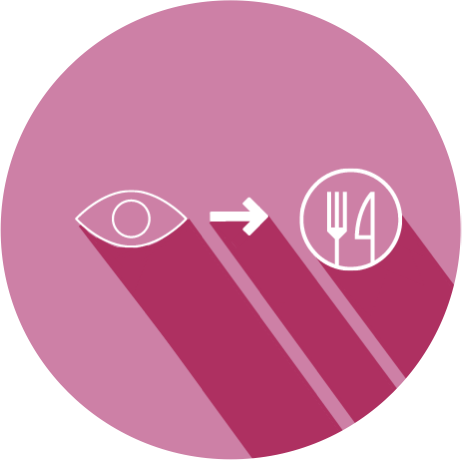The Form of Taste: How Shapes Influence Taste & How You Can Apply This to Influence Consumers
Relevant topics Research, Archive
Rationally speaking, forms wouldn’t have a taste. A circle is a circle and that’s that. Or isn’t it quite that simple?
Although shape and taste are two different sensory experiences, shape does influence taste. Researchers have found that we as humans associate taste qualities with different design features such as curvature, texture, orientation, symmetry, and so on. In fact, the shape of everything, from the product itself to the typeface in which it is presented and the shapes of/on product packaging have all been shown to influence people’s expectations, and sometimes even their experiences.
In this blog we will take a closer look at how shape influences taste and how you could use that knowledge to increase the attractiveness of your product.
Shapes and Tastes
A rounded Chardonnay, a sharp Cheese; using shapes and forms to describe taste isn’t that uncommon. But how do we understand each other when we use these words? We somehow have a shared understanding about how shapes taste. Let’s dive into a few associations.
Round = Sweet & Creamy
An extensive body of research conducted over the last decade has demonstrated that people intuitively match roundness with sweetness. Furthermore, roundness is often associated with creaminess, thereby accentuating this property of food products. On the contrary, sourness and spiciness are strongly associated with angularity. Thus, as a product marketeer, you should think about which qualities you would like to accentuate and select a shape that corresponds with that.
A fun anecdote about how shape influences taste is found in the story of Cadbury. The chocolate manufacturer rounded the corners of their chocolate bars. Clever, because they could sell a couple of grams less chocolate for the same price. Or wasn't it that clever? Within days, they started getting numerous complaints from customers, saying that the taste had changed and that it was creamier and sweeter than before. Although Cadbury didn’t change the recipe, changing the shape was enough to change the experience of customers.
Sweet = Higher
It has also been reported that sweet tastes are associated with higher locations. This may be due to the higher pitch that tends to be associated with sweetness. It might thus be that on supermarket shelves, sweet products would be more easily found higher, while bitter-tasting foods would grab attention faster in lower shelves. However, this has not been proven yet.
Sour = Fast
Beside shape-taste associations, we also have speed-taste associations. For example, most people will rate lemons as “fast” rather than “slow”, whereas prunes and bananas are commonly rated as slow. It could be that this is due to the fact that acids are much more soluble in saliva, and hence are perceived more rapidly than the other basic features. For supermarkets, it might be interesting to test whether categorizing products on this speed feature would affect consumer behavior.
Tasting Typefaces
As mentioned above, round is often associated with sweetness. That is not only the case for the product itself. Even the typeface in which the product is presented (for example used to communicate the product’s name on a package) can influence expectation and thereby taste. Velasco et al. (2015) for example found that people associated sweetness with a more rounded typeface while associating angular typefaces with the other basic tastes.
Thus, an important choice to make as a brand is whether you want to use a round font or an angular font, as it has an effect on the taste experience.
Product Packaging
Also the form of the packaging can affect expectations and experience. In general, rounded packaging forms are both more approachable and linked with sweetness. In addition, it was found that while square packs make the taste of yogurt fuller, round ones will make the taste softer (Becker et al, 2011).
With the packaging shape you will therefore accentuate the positioning of your product. Therefore, it is smart to first have a clear picture of how you want to position your product and then design your product’s packaging to align this positioning.
Key Take-Aways
- Shapes influence taste
- While round shapes accentuate sweetness and creaminess, angular shapes accentuate sourness and spiciness.
- This is not only true for the product shape itself, but also for the typeface in which it is presented. It is therefore smart to use a typeface that fits your product’s positioning.
- The form of a package also influences taste. For example, square packs were found to make the taste of yogurt fuller, round ones made the taste softer. Use a form that fits your product.
Further Reading
-
Is Fondness for Roundness a thing? How to increase buying intentions for indulgence foods with a basic shape
Think about two similar scenarios where you want to treat yourself. One: you just left the gym after a long day. It was a good session. You ate your frog and managed to tick almost everything off your list. You have a hankering for something good to say “You did well today”.
Two: you just left the office, it’s late in the evening and you want a little pick me up. Another day at the office, a lot of overtime with little moments of reflection. You rarely have time for yourself, but you are the best at your job, and you love it. You want something good to ease your relaxation and end the day.
What do you pick in each of them? A chocolate cheesecake sounds just as good as a pack of graham crackers. You will say: “My choice can come down to many things! My plans for the evening, the package and its colors, how, and if it smells. Should I go on?”. Well, yes and no.
-
Let your eyes feast on this! How visual packaging elements change taste expectations
The purpose of food packaging has evolved a lot from what it used to be. At first, packaging was mainly used as a means to preserve and transport food items. Later, it was used as a way to gain consumers’ attention in shops and influence their preferences. More recently, a growing interest has been placed on how packaging can contribute to the multisensory experience of consumption.
But how come that something like packaging, which does not objectively alter the actual taste of food, can have so much impact? Let’s delve into how visual elements on food packaging can change taste expectations!


